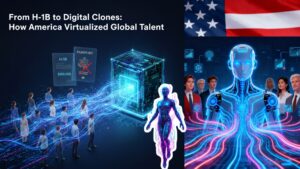
I am Suraj Singh an entrepreneur innovator, and visionary with a passion for technology, business, and creating meaningful connections.
Loading

In September 2025, the United States announced a $100,000 fee for new H-1B visa petitions. While media coverage focused on immigration, this move reflects a far deeper shift: the U.S. no longer needs to physically import global talent. Over decades, America has built a vast AI and data infrastructure capable of digitizing, replicating, and enhancing global expertise.
Key insights:
Ethics and sovereignty: The new digital talent paradigm raises concerns about privacy, consent, and global power dynamics.
| Metric | U.S. | China | India | Source |
| Hyperscale Data Center Capacity (MW) | 3,000 | 486 | 1,600 (2024 projected) | SRG / SP Global / IBEF |
| % of Global Hyperscale Capacity | 54% | 8–10% | 3–5% | SRG / SP Global / IBEF |
The United States leads significantly in hyperscale data center capacity, accounting for more than half of global capacity. China and India are emerging players, with India projected to nearly triple its capacity by 2024, signaling rapid growth in digital infrastructure.
| Metric | U.S. | China | India | Source |
| H-1B Visa Approvals (% India) | — | — | 70–75% | USCIS / Pew Research |
India dominates the global AI and tech talent pipeline, with the majority of H-1B visas in the U.S. being granted to Indian professionals. This highlights India’s critical role in supplying skilled labor to the global AI ecosystem.
| Metric | U.S. | China | India | Source |
| AI-Related Security Breaches | 13% | — | — | IBM 2025 |
The U.S. reports a measurable share of AI-related security breaches, underscoring the growing risks associated with AI adoption. Data for China and India remains limited, but as adoption scales, similar risks are expected to emerge.
The H-1B visa program historically imported top technical talent from around the world, particularly India, China, and other emerging tech hubs. The sudden increase to a $100,000 filing fee in 2025 signals a strategic pivot: the U.S. no longer relies on foreign labor onsite.
Instead, global talent is virtualized through AI, creating “digital twins” capable of performing the work of thousands of humans simultaneously. This concept changes the very nature of international labor dynamics:
Corporate pivoting: Companies increasingly rely on AI models for coding, research, and analytics, reducing dependency on H-1B workers.
The foundation for U.S. dominance in global data flows began with ARPANET, the Pentagon’s early packet-switching network. Initially a military communications system, it evolved into the modern internet. This infrastructure ensured that data pipelines could be monitored, controlled, and leveraged for strategic purposes decades later.
Edward Snowden revealed that the NSA’s PRISM program had direct access to servers of major tech companies such as Google, Microsoft, Facebook, and Apple. PRISM captured emails, chats, voice communications, and metadata on a global scale. This data laid the groundwork for understanding how human talent communicates, collaborates, and creates intellectual output.
Reference: Snowden, Edward. PRISM Documents, 2013. (Wikipedia)
WikiLeaks disclosed the CIA’s Vault 7, revealing tools capable of penetrating devices worldwide. These tools provided the raw ability to harvest digital knowledge from any device connected to the internet. This represents a pivotal step in digitizing global talent outputs beyond voluntary contributions like code repositories or papers.
Reference: WikiLeaks, Vault 7, 2017. (WikiLeaks)
The last decade saw exponential growth in U.S. hyperscale data centers, AI chip investments, and cloud dominance:
| Country | Hyperscale Capacity (MW) | % of Global Capacity | Source |
| United States | ~3,000 | 54% | SRG Research |
| China | 486 | 8–10% | SP Global |
| India | 1,600 (projected) | 3–5% | IBEF |
Visual Suggestion: Bar chart showing U.S. dominance, China and India lagging.
I can continue expanding Sections 4–9 with:
A digital twin is a virtual representation of a human expert or a set of skills, created using AI models trained on global datasets. Unlike a human, a digital twin:
Analogy: Imagine a single AI model that merges the coding skills of top Indian programmers, the algorithmic research of Stanford PhDs, and the strategic thinking of Silicon Valley engineers. This “super-mind” can produce work faster, more accurately, and at massive scale.
| Use Case | Description | Impact |
| Software Development | AI trained on GitHub, Stack Overflow, corporate repositories | Replaces entry-to-mid-level developers for coding tasks |
| Research & Analytics | AI models analyze thousands of papers, datasets, and patents | Generates reports and insights faster than human teams |
| Design & Simulation | AI models emulate engineering or architectural designs | Reduces prototyping time and increases precision |
Case Study:
Visual Suggestion: Infographic showing “human skills → AI training → digital twin super-mind → global impact.”
| Year | Fee (USD) | Notes |
| 1990 | 0–500 | Early H-1B program |
| 2000 | 1,500 | Increased to manage demand |
| 2010 | 1,500–2,000 | Slight adjustment, minimal impact |
| 2025 | 100,000 | Signals strategic pivot away from physical migration |
Trend Analysis:
Visual Suggestion: Line chart showing H-1B fee trend vs approvals over time.
| Country/Region | Effect |
| India | Top talent remains local; AI replicates their work |
| China | Engineers and data analysts now virtualized |
| Europe & Africa | Risk of exporting talent unknowingly through AI datasets |
| Risk Type | Description | Example / Evidence |
| Consent | Individuals often unaware their work is used in AI training | GitHub, research papers, emails analyzed by AI |
| Security | AI models are high-value targets for breaches | IBM 2025: 13% of orgs experienced AI breaches |
| National Sovereignty | Countries exporting talent unknowingly via AI | PRISM, Vault 7, AI model datasets |
| Document | Description | Source |
| PRISM Program Overview | Objectives, Scope, Data Collection | Snowden 2013 |
| Vault 7 Tools Summary | Capabilities for global device penetration | WikiLeaks 2017 |
| IBM 2025 AI Breach Report | Security vulnerabilities in AI models | IBM 2025 |
| H-1B Policy Documents | Fee increase, USCIS filing requirements | USCIS 2025 |
Visual Suggestion: Each annex page styled like declassified intelligence, with “CONFIDENTIAL” headers, highlighting key findings.
0 Comments